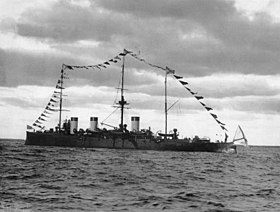Isumrud
|
|
|
|---|---|
| Isumrud class | |
 Sister ship Schemchug on September 27, 1904 off Tallinn |
|
| Overview | |
| Type | Protected cruiser |
| units | 2 |
| Shipyard | |
| Keel laying | January 1901 |
| Launch | October 22, 1903 |
| period of service |
1904 to 1905 |
| Commissioning | 1904 |
| Whereabouts | Run aground after the sea battle of Tsushima, sunk at Cape Orenkov |
| Technical specifications | |
| displacement |
Standard: 3,103 t |
| length |
110.95 m KWL |
| width |
12.2 m |
| Draft |
4.90 m |
| crew |
354 men |
| drive |
16 coal-fired Yarrow steam boilers |
| speed |
24.5 kn |
| Range |
2090 nm at 12 kn |
| Armament |
• 8 × 120 mm L / 45 canet guns |
| Bunker quantity |
510 tons of coal |
| Armor |
|
| Commanders Captains 2nd rank |
|
The Isumrud ( Russian Изумруд , German Smaragd ) was a protected cruiser of the Imperial Russian Navy . The ship belonged to the Isumrud class and was also the type ship. There was only one other ship of this class, the sister ship Shemchug . The Isumrud class was a modification of the previous cruiser Nowik . The cruiser was laid down in January 1901 at the Nevsky Naval Shipyard in Saint Petersburg , but was not launched until 1903 after construction delays. After further delays, including due to ice storms, the Isumrud was accelerated further after the beginning of the war with Japan .
The ship entered service in October 1904 and was assigned to the Second Pacific Squadron .
Russo-Japanese War
Under the command of Captain Wassili Fersen, she took part in the naval battle near Tsushima on May 27 and 28, 1905. Towards the end of the battle, the captain refused to capitulate, according to Admiral Nikolai Nebogatov's orders , and escaped the Japanese at high speed. However, the Isumrud ran aground in Vladimir Bay the following night and was abandoned. She sank to 43 ° 54 '0 " N , 135 ° 30' 0" O at Cape Orjenkow on May 30, 1905. The team reached Vladivostok over land .
The ship was removed from the list on September 15, 1905 and sold for demolition in 1908.
literature
- Bernhard Gomm: The Russian Warships 1856-1917, Volume II: Frigates, Armored Cruisers, Corvettes, Protected Cruisers, Appendix: Sailing Frigates 1694-1856. Self-published, Wiesbaden 1991